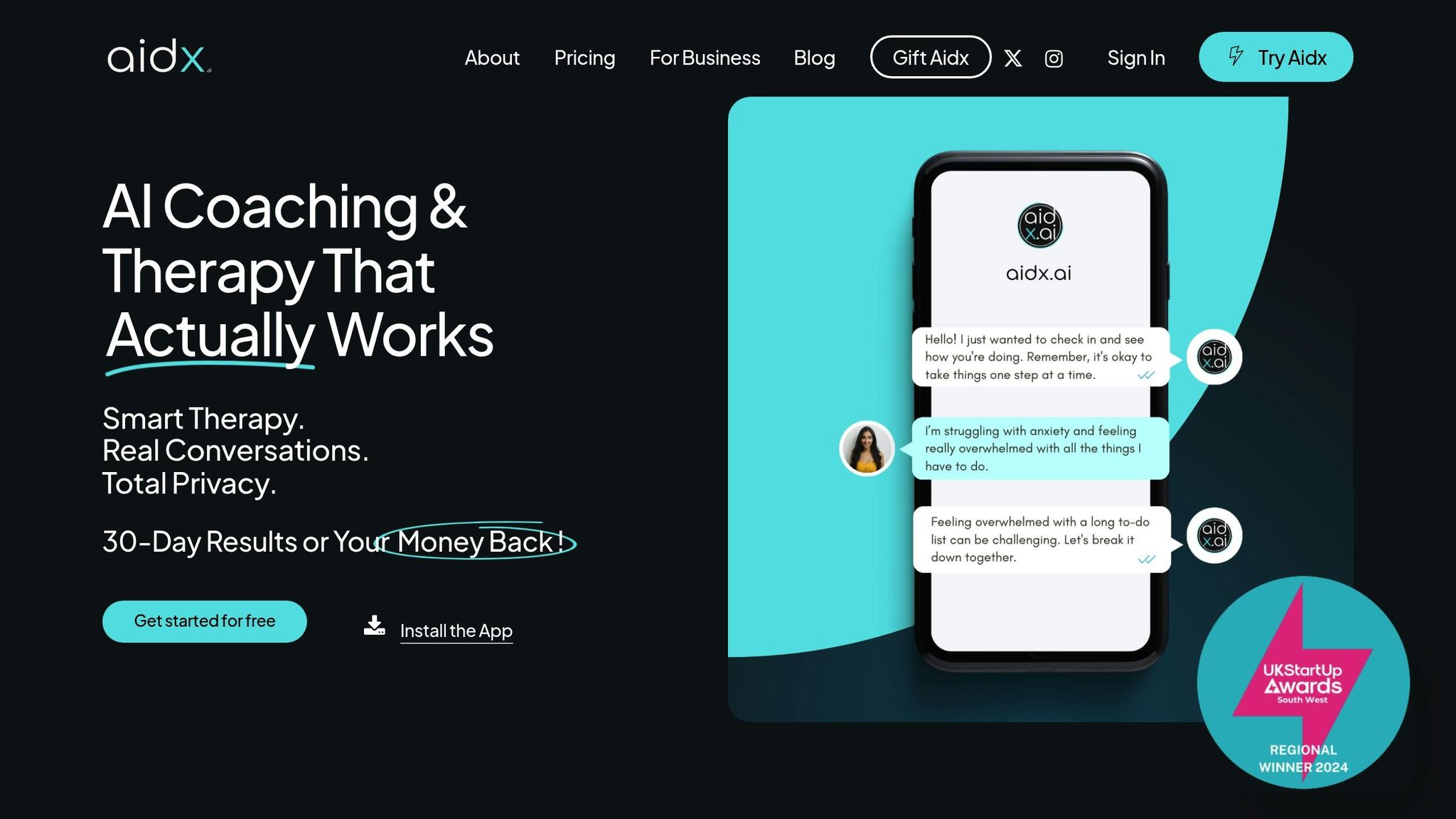AI emotion recognition is transforming mental health care by identifying emotional states through facial expressions, voice patterns, and bio-signals. This technology improves early detection of mental health issues, supports treatment, and enables continuous monitoring. For example, tools like emotion-aware chatbots and wearable devices provide real-time emotional analysis, making mental health support more accessible and effective.
Key Highlights:
- Early Detection: AI identifies signs of depression, anxiety, and stress through speech, language, and facial cues.
- Treatment Support: Therapists use AI insights to adjust treatments, with studies showing up to a 64% reduction in depressive symptoms.
- 24/7 Monitoring: Virtual therapy platforms and apps offer round-the-clock emotional support.
- Market Growth: The global Emotion AI market, valued at $2.9 billion in 2024, is growing 21.7% annually.
AI-based systems like Aidx.ai combine real-time emotion analysis with therapeutic techniques, offering personalized mental health support that complements traditional care. While these tools are not a replacement for human therapists, they bridge gaps in care, especially in underserved areas. However, ethical concerns like data privacy and AI bias remain critical to address.
The Rise of Emotional AI: How Machines Understand Feelings
How AI Emotion Recognition Works
AI emotion recognition systems analyze various signals to interpret emotional states. This technology not only deciphers emotions but also supports early intervention in mental health care.
Core Detection Technologies
Modern emotion recognition platforms rely on three main technologies:
Facial Analysis Systems
Using advanced computer vision, these systems track micro-expressions and subtle muscle movements that reveal emotions. They analyze dozens of facial landmarks, capturing even the smallest changes in real time.
Voice Pattern Recognition
Specialized algorithms process speech to uncover emotional cues by examining:
- Pitch variations
- Rhythm and pace of speech
- Tone shifts
- Voice intensity
Natural Language Processing (NLP)
Sophisticated language models evaluate spoken or written words to detect emotional undertones. For instance, a chatbot equipped with emotion-aware NLP can identify signs of distress through nuanced language analysis [1].
"AI-based sentiment analysis can detect potential mental health complications before they escalate by observing a person’s tone of voice, word choices, and facial micro-expressions during therapy or remote consultations", states the 2024 NIH report [2].
Mental Health Uses
In mental health care, AI emotion recognition plays a vital role in several areas:
Early Detection Systems
These systems identify early signs of mental health challenges, such as:
- Depression through language patterns
- Anxiety via speech and facial cues
- Stress by monitoring physiological responses
- Emotional distress through behavioral signals
Treatment Support
AI-powered tools provide therapists with objective emotional insights, helping them adjust treatments quickly. For example, AI therapy programs have been shown to reduce depressive symptoms by up to 64% [2].
Continuous Monitoring
Emotion tracking can now happen around the clock through:
- Virtual therapy platforms
- Remote consultations
- Wearable devices
- Mobile apps
This round-the-clock monitoring is especially helpful in areas with limited access to mental health professionals, ensuring consistent emotional support and timely intervention [2]. The integration of multi-signal detection and real-time analysis continues to refine the capabilities of these systems.
The rapid growth in this field highlights the increasing precision and reliability of emotion recognition technologies [2]. These advancements pave the way for even faster and more efficient systems, which will be explored in the next section.
Latest AI Emotion Detection Progress
AI emotion recognition has seen impressive advancements, particularly in its use for mental health support. The global emotion AI market was valued at $2.9 billion in 2024 and is expected to grow at an annual rate of 21.7% from 2025 to 2034. This growth is fueled by breakthroughs in detection technologies and a rising demand for mental health solutions[2]. Recent developments have expanded the capabilities of emotion recognition systems, pushing their potential even further.
Multi-Signal Detection Systems
Modern AI platforms now combine multiple data sources to improve accuracy. These systems merge physiological data from devices like smartwatches and fitness trackers with advanced signal processing techniques. Key inputs include:
- Facial expressions, including subtle micro-expressions
- Variations in voice patterns
- Physical responses like heart rate and skin conductivity
- Language and speech patterns
This multi-signal approach enables real-time analysis, offering immediate insights that can be applied in mental health interventions.
Instant Emotion Analysis
Advanced Language Processing
In February 2025, researchers at Keele University introduced an emotion-aware chatbot designed for psychological first aid. This chatbot leverages BERT training, GPT fine-tuning, and real-time distress detection to provide immediate emotional support[1].
24/7 Therapeutic Support
Today’s emotion AI systems are equipped to deliver constant monitoring and support, offering several key benefits:
| Feature | Benefit |
|---|---|
| Real-time Analysis | Detects emotional distress instantly |
| Adaptive Response | Offers tailored interventions |
| Continuous Monitoring | Provides around-the-clock emotional support |
| Data Integration | Analyzes emotional patterns comprehensively |
These systems have proven especially valuable in areas where access to mental health professionals is limited. Virtual assistants can now step in to provide immediate help, track emotional changes in real time, and trigger timely interventions when needed[2].
This progress is particularly critical given the mental health challenges faced by many. For instance, 57.8 million adults in the U.S. were affected by at least one mental disorder in 2024[2]. As emotion AI continues to evolve, it is making mental health care more accessible, timely, and effective.
sbb-itb-d5e73b4
Personal Mental Health Support with AI
Thanks to advancements in emotion detection, AI-driven tools are now helping individuals take a more proactive approach to their mental health. Research reveals that 75% of people are open to trying AI-based mental health support, with men being three times more likely to embrace AI therapy compared to women [3]. Platforms like Aidx.ai are leading the charge by combining real-time emotion analysis with tailored therapeutic techniques.
How Aidx.ai Works

Aidx.ai uses its Adaptive Therapeutic Intelligence (ATI) System™ to provide personalized mental health support. This system integrates a voice-enabled interface with proven therapeutic approaches like CBT, DBT, ACT, and NLP, adjusting its methods in real time based on the user’s emotional state [3].
Here’s what the platform offers:
| Feature | Benefit |
|---|---|
| Voice-First Interface | Allows natural, hands-free conversations during daily routines |
| Real-Time Emotion Analysis | Delivers immediate, tailored support based on emotional cues |
| Multi-Channel Support | Accessible via web, mobile apps, and messaging platforms |
| Progress Tracking | Tracks emotional trends and improvements over time |
By combining technology with empathy, Aidx.ai offers a practical and accessible way to address mental health needs.
"As a mental health professional committed to supporting individuals who struggle with how their thoughts and feelings impact them, I was intrigued about the concept of Aidx. After trying it for myself I have found that it has had a positive influence on how I approach my own issues and difficulties. I found its timely and personalised email reminders to be useful to help me reflect on previous problems and also to remind me to seek help again when needed. It also helped me to see things from a different perspective, reminded me how to problem-solve for myself, and gave me reassurance that there was support that I could rely on (any time of the day or night) if and when I needed it. I would recommend Aidx to anyone, and I can see how it could be a great tool and addition to the experience my own clients could have." [3]
Blending AI with Human Care
AI tools like Aidx.ai don’t just stand alone – they work alongside human care to create a more seamless support system. These tools can bridge the gaps between therapy sessions, reduce costs by as much as 80%, and enhance collaboration between individuals and their therapists [3].
Clinical Hypnotherapist Salvija shared her experience:
"I was quite excited to test Aidx.ai, as a person who is curious how far AI will impact our lives I was waiting ’till it enters the mental health sector and especially helping people. Being a practitioner I always aim to explore new things that can help my clients too or can recommend great alternatives when necessary. My experience with Aidx was impressive, it offered great support and ideas, was able to have fluent conversations, on top of that it checked in with me. It has areas to improve as any system, but I think it is a brilliant tool for anyone who needs support quickly and maybe hasn’t found their therapist yet or can’t afford a session for the moment. It is truly game changing and will shake the industry very quickly." [3]
Strength & Mobility Coach Hali also praised the platform:
"Aidx has been surprisingly human in identifying problems & asking the right questions. But faster! I got sucked into the conversation like I was talking to an educated & empathetic therapist & every suggestion sent me to where I needed to go. When you’re in quick need of help, attention & direction I think this will be an incredible tool to help people find & hear what they need so they can then take the next necessary steps." [3]
Ethics and Privacy
As AI emotion recognition becomes more integrated into mental health care, maintaining strong safeguards is critical. These measures not only protect user data but also build trust and ensure compliance with legal standards like data protection regulations.
Data Protection Methods
Mental health data demands the highest level of security. To address this, modern AI platforms employ multiple layers of protection:
| Security Measure | Implementation |
|---|---|
| Encryption | End-to-end encryption for both transmission and storage |
| Access Control | Strict authentication protocols and limited data access |
| GDPR Compliance | Adherence to EU data protection standards |
| Data Retention | Clear policies for storage duration and timely deletion |
Take Aidx.ai as an example. The platform ensures private, encrypted conversations and guarantees that no user data is sold to corporations. Additionally, it offers an "Incognito Mode", which automatically deletes session data after 30 minutes, giving users more control over their privacy [3]. While these measures protect sensitive information, addressing potential biases in AI systems is just as important.
"We want to earn your trust! So we have created a quick overview where you can get answers to questions like: – Do you sell or share my data? – Who reads my conversations? – How is my data secured? – Are you GDPR Compliant?" – Aidx.ai [3]
Reducing AI Bias
Beyond data protection, ensuring fairness in AI systems is essential. Bias in AI can lead to unequal outcomes, which is particularly concerning in mental health applications. To reduce this risk, platforms should focus on:
- Diverse Training Data: Using datasets that represent a broad range of demographics to avoid skewed results.
- Regular Auditing: Monitoring system performance across various user groups to identify and address disparities.
- Transparent Algorithms: Offering clear documentation that explains how the system makes decisions and provides recommendations.
These steps help create a more equitable and secure environment for users relying on AI in mental health care.
Conclusion
AI-powered emotion recognition is reshaping the way mental health support is delivered, making it faster, more accessible, and effective for millions. Recent statistics highlight a surge in adoption, with these tools breaking down traditional barriers to care by offering affordable and widely available solutions. This progress not only improves access but also strengthens the role of AI in everyday mental health services.
Building on earlier developments, these systems enhance virtual support and enable more consistent care. Mental health professionals are increasingly acknowledging AI’s role as a valuable companion to traditional methods. As one practitioner shared, platforms like Aidx offer meaningful assistance while working alongside established therapeutic practices.
That said, it’s important to remember that AI is a supportive tool – not a replacement for traditional care. These systems are designed to provide immediate help and complement conventional therapy, but they cannot substitute human care for serious mental health conditions like major depression, psychosis, or severe anxiety disorders [3]. The future of mental health care lies in a thoughtful blend of AI emotion recognition technology and human expertise, creating a more inclusive and effective support network for all.
FAQs
How does AI-powered emotion recognition help identify and treat mental health issues earlier?
AI-powered emotion recognition leverages sophisticated algorithms to interpret facial expressions, voice tones, and text patterns. This allows it to identify signs of stress, anxiety, or depression as they happen. By catching these emotional cues early, it opens the door for timely interventions and tailored support, potentially stopping problems from growing worse.
This technology is reshaping mental health care by providing constant monitoring and adaptive insights. It helps both individuals and professionals gain a clearer picture of emotional trends, measure progress, and apply proven strategies to enhance mental well-being.
What are the ethical considerations of using AI for emotion recognition in mental health, and how are they being managed?
AI emotion recognition in mental health brings up several ethical challenges, including concerns about privacy, data security, algorithmic bias, and the risk of becoming overly dependent on technology. Protecting users’ personal information is a major focus, with platforms adopting measures like data encryption, compliance with GDPR, and privacy settings that give users control over their information.
Another pressing issue is bias in AI systems. To avoid unfair or inaccurate results, these systems need to be trained on diverse datasets. Developers are working hard to make algorithms more fair and transparent. Many tools, such as Aidx.ai, are built to work alongside human professionals instead of replacing them. This combined approach ensures users still benefit from the nuanced and empathetic care that only human practitioners can provide, addressing some of AI’s inherent limitations.
How can AI emotion recognition enhance traditional mental health care, particularly in areas with limited access to professionals?
AI emotion recognition systems have the potential to significantly enhance traditional mental health care by providing real-time emotional insights and support. These systems can identify and track emotional states, helping individuals gain a clearer understanding of their feelings. They also offer immediate tools to address stress, anxiety, or other emotional challenges – an especially valuable resource for those without regular access to therapists or counselors.
On top of that, AI-powered platforms can fill critical gaps in care by delivering on-demand, around-the-clock support. They offer personalized guidance tailored to a user’s specific emotional state and personal goals. This means that even in areas where mental health resources are scarce, people can still access practical, research-backed techniques to improve their emotional health.



